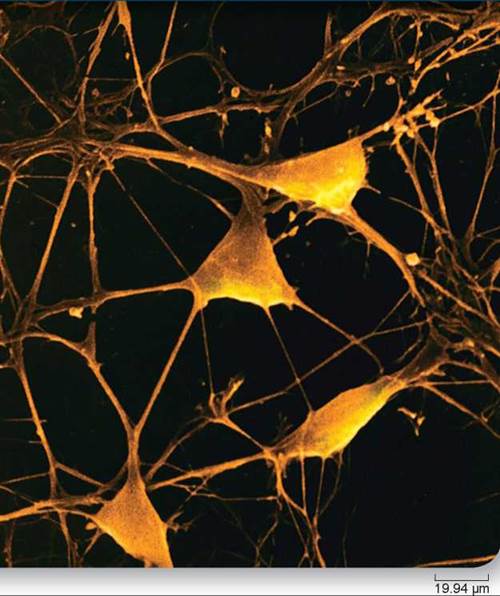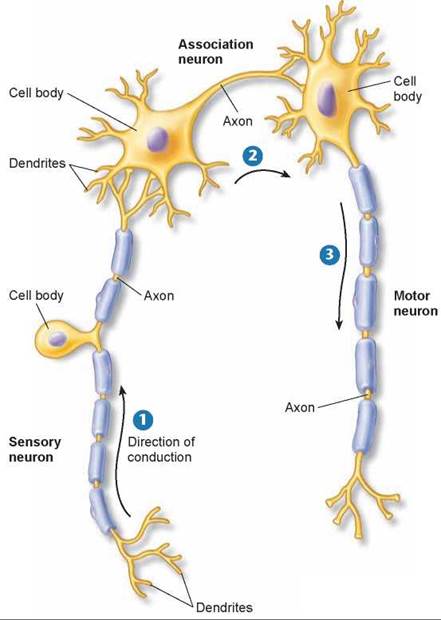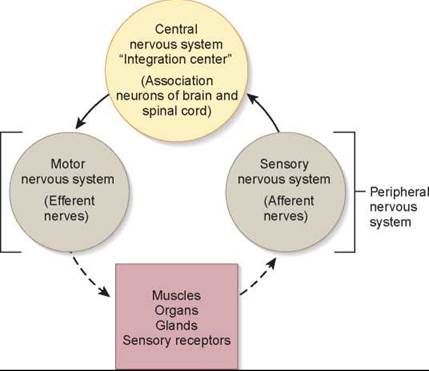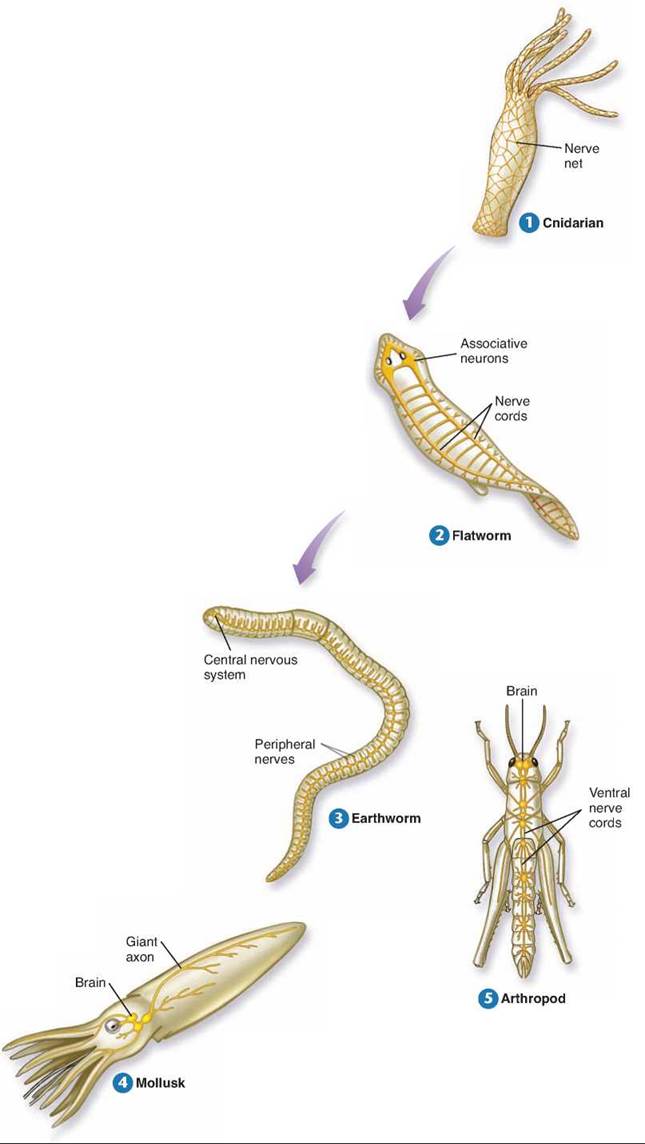THE LIVING WORLD
Unit Six. Animal Life

In vertebrates, the central nervous system coordinates and regulates the diverse activities of the body, using a network of specialized cells called neurons to direct the voluntary muscles, and a second network not under voluntary control to direct cardiac and smooth muscles. All sensory information is acquired through depolarization of sensory nerve endings. From a knowledge of which neurons are sending signals, and how often they are doing so, the brain builds a picture of the body’s internal condition and of the external environment. The network of neurons (nerve cells) seen here, magnified over a thousand times, is transmitting signals within the portion of the brain called the cerebral cortex. The vertebrate brain contains a staggering number of neurons—the human brain contains an estimated 100 billion. The cerebral cortex is a layer of gray matter only a few millimeters thick on the brain’s outer surface. Densely packed with neurons and highly convoluted, it is the site of higher mental activities.
28.1. Evolution of the Animal Nervous System
An animal must be able to respond to environmental stimuli. To do this, it must have sensory receptors that can detect the stimulus and motor effectors that can respond to it. In most invertebrate phyla and in all vertebrate classes, sensory receptors and motor effectors are linked by way of the nervous system. As described in chapter 22, the nervous system consists of neurons (figure 28.1) and supporting cells. One type of neuron, called association neurons (or interneurons), is present in the nervous systems of most invertebrates and all vertebrates. These neurons are located in the brain and spinal cord of vertebrates, together called the central nervous system (CNS), represented by the yellow circle in figure 28.2. They help provide more complex reflexes and in the case of the brain, higher associative functions, including learning and memory, which require integration of many sensory inputs.

Figure 28.1. Three types of neurons.
Sensory neurons carry information about the environment to the brain and spinal cord. Association neurons are found in the brain and spinal cord and often provide links between sensory and motor neurons. Motor neurons carry impulses to muscles and glands (effectors).
There are two other types of neurons. Sensory (or afferent) neurons (1 in figure 28.1) carry impulses from sensory receptors to the CNS. Motor (or efferent) neurons 3 carry impulses away from the CNS to effectors—muscles and glands. The association neurons 2 link these two types of neurons together in the CNS. Together, motor and sensory neurons constitute the peripheral nervous system (PNS) of vertebrates (the bracketed tan circles in figure 28.2).

Figure 28.2. Organization of the vertebrate nervous system.
The central nervous system, consisting of the brain and spinal cord, issues commands via the motor nervous system and receives information from the sensory nervous system. The motor and sensory nervous systems together make up the peripheral nervous system.
Invertebrate Nervous Systems
Sponges are the only major phylum of multicellular animals that lack nerves. If you prick a sponge, the nearby surface contracts slowly. The cytoplasm of each individual cell conducts an impulse that fades within a few millimeters. No messages dart from one part of the sponge body to another, as they do in all other multicellular animals.
The Simplest Nervous Systems: Reflexes. The simplest nervous systems occur among cnidarians, like the Hydra 1. All neurons are similar, each having fibers of approximately equal length. Cnidarian neurons are linked to one another in a web, or nerve net, dispersed through the body. Although conduction is slow, a stimulus anywhere can eventually spread through the whole net. There is no associative activity, no control of complex actions, and little coordination. Any motion that results is called a reflex because it is an automatic consequence of the nerve stimulation.
More Complex Nervous Systems: Associative Activities. The first associative activity in nervous systems is seen in the free-living flatworms 2, phylum Platyhelminthes. Running down the bodies of these flatworms are two nerve cords, looking like the uprights of a ladder; peripheral nerves extend outward to the muscles of the body. The two nerve cords converge at the front end of the body, forming an enlarged mass of nervous tissue that also contains associative neurons that connect neurons to one another. This primitive “brain” is a rudimentary central nervous system and permits a far more complex control of muscular responses than is possible in cnidarians.
The Evolutionary Path to the Vertebrates. All of the subsequent evolutionary changes in nervous systems can be viewed as a series of elaborations on the characteristics already present in flatworms. Five trends can be identified, each becoming progressively more pronounced as nervous systems evolved greater complexity.
1. More sophisticated sensory mechanisms. Particularly among the vertebrates, sensory systems become highly complex.
2. Differentiation into central and peripheral nervous systems. For example, earthworms 3 exhibit a central nervous system that is connected to all other parts of the body by peripheral nerves.
3. Differentiation of sensory and motor nerves. Neurons operating in particular directions become increasingly specialized (sensory signals traveling to the brain, or motor signals traveling from the brain).
4. Increased complexity of association. Central nervous systems with more numerous interneurons evolved, increasing association capabilities dramatically.
5. Elaboration of the brain. Coordination Brain of body activities became increasingly localized in mollusks 4, arthropods 5, and vertebrates in the front end of the nerve cord, which evolved into the vertebrate brain discussed later in the chapter.

Key Learning Outcome 28.1. As nervous systems evolved, there was a progressive increase in associative activity, increasingly localized in a brain.